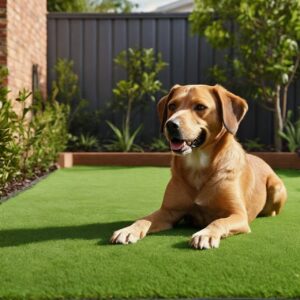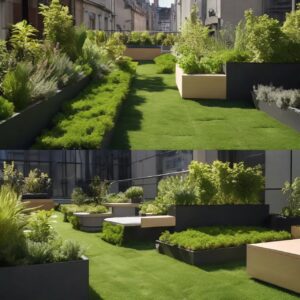As homeowners and commercial property managers increasingly seek sustainable, low-maintenance landscaping solutions, artificial grass is emerging as a top choice. The artificial turf market, already substantial, is projected to expand from USD 8.105 billion in 2021 to an impressive USD 12 billion by 2027, growing at a CAGR of over 7.7%. This surge is driven by the demand for durable, cost-effective, and aesthetically pleasing options for outdoor spaces. Whether you’re looking to enhance the beauty of your home’s lawn or seeking a practical solution for commercial landscaping, artificial grass offers numerous advantages. From significant water savings to consistent year-round greenery, the benefits align perfectly with the needs of modern residential and commercial properties. In this article, we’ll explore 30 compelling benefits of artificial grass, highlighting why it’s an increasingly popular choice for those who value both beauty and functionality in their outdoor spaces.
1. Durability and Longevity
Artificial grass boasts remarkable durability, lasting up to 25 years. It is designed to withstand extensive use and resist fading, even in high-traffic areas. This longevity is particularly beneficial for public spaces, sports facilities, and homes with pets or children. The resilience of synthetic turf means it retains its aesthetic appeal and functionality over many years, far outlasting natural grass.
2. Low Maintenance
One of the primary benefits of artificial grass is its minimal maintenance requirements. Unlike natural lawns, it doesn’t need regular mowing, watering, or seeding. This not only saves time and effort but also reduces the need for lawn care equipment. Over time, the reduction in maintenance can lead to significant cost savings and a more convenient lifestyle for homeowners.
3. Water Conservation
Synthetic turf plays a crucial role in conserving water. In regions prone to droughts or where water conservation is essential, replacing natural grass with artificial turf can significantly reduce water usage. This aspect is particularly relevant for large areas like sports fields and public parks, where watering natural grass can be extremely water-intensive. The environmental impact of saving water is substantial, benefiting ecosystems and communities.
4. No Chemicals Required
Artificial grass eliminates the need for fertilizers, pesticides, and herbicides. This is not only beneficial for the environment by reducing chemical runoff but also safer for families and pets. By avoiding these chemicals, homeowners contribute to a healthier local ecosystem. Furthermore, the absence of harsh chemicals makes artificial grass a safer choice for public spaces and schools.
5. Aesthetically Pleasing All Year Round
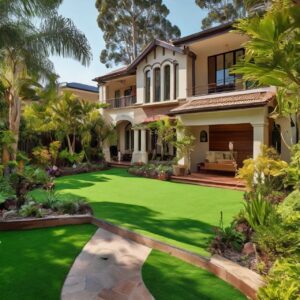
Artificial turf maintains its green and lush appearance throughout the year. It is immune to the common problems of natural grass, such as discoloration, patchiness, or seasonal browning. This year-round aesthetic appeal is especially beneficial for maintaining the appearance of lawns, sports fields, and commercial properties. Moreover, artificial grass ensures that outdoor spaces are always ready for use, regardless of the season.
6. Safe for Children and Pets
Many artificial grass products are made with safety in mind, providing a non-toxic and cushioned surface. This makes it an excellent choice for children’s play areas and pet-friendly yards. The softness of the turf helps to prevent injuries from falls, and its non-toxic nature ensures that it’s safe for pets and children to play on. Additionally, the lack of pesticides and fertilizers contributes to a safer environment for play and relaxation.
7. Environmentally Friendly
Artificial grass contributes positively to the environment in several ways. By reducing the need for water and chemicals, it lessens the strain on natural resources. It also diminishes the reliance on gas-powered lawn equipment, which helps reduce carbon emissions. Moreover, some artificial turf is made from recycled materials, further lessening its environmental footprint.
8. Cost-Effective
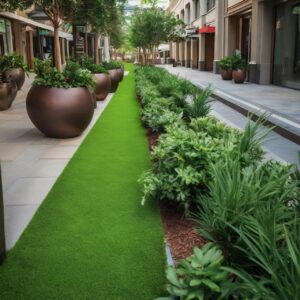
Though the upfront cost of artificial grass can be higher than natural grass, it becomes more cost-effective over time. The savings on water bills, lawn care products, and maintenance equipment add up. Additionally, the long lifespan of synthetic turf means it doesn’t need to be replaced as frequently as natural grass, leading to long-term savings. This cost-effectiveness is particularly significant for large areas like sports fields and public parks.
9. Versatile Design Options
Synthetic grass offers a variety of design options. It comes in different shades of green, various textures, and multiple pile heights, allowing customization to fit any landscaping theme. This versatility makes it suitable for everything from ornate gardens to practical play areas. The ability to tailor its appearance also means that it can blend seamlessly with existing natural landscapes or create a unique look.
10. No Mud or Dirt
One of the practical benefits of artificial turf is the elimination of mud and dirt. This is especially advantageous in rainy climates where natural grass can become muddy and unmanageable. It keeps outdoor spaces clean and usable, regardless of the weather. For households with children and pets, this means less cleaning and no muddy footprints or paw prints inside the home.
11. UV Resistant
High-quality artificial grass is treated to be UV resistant, ensuring it maintains its color and does not fade under the sun. This resistance to sun damage is crucial for preserving the aesthetic appeal of the turf over time. It’s particularly important in areas with strong sunlight exposure, where natural grass can quickly turn brown. UV resistance also contributes to the longevity of the product, making it a lasting investment.
12. Pest-Free Environment
Artificial grass is less appealing to pests than natural grass. It does not provide a habitat or food source for insects, reducing the presence of bugs in your garden. This feature is especially beneficial for families who want to enjoy their outdoor spaces without the annoyance of insects. Additionally, the lack of pests means there’s no need for insecticides, further contributing to a safer and more environmentally friendly outdoor area.
13. Allergy Reduction
For those suffering from grass allergies, artificial turf is an excellent solution. It does not produce pollen, which is a common trigger for allergy symptoms. This benefit is particularly valuable during the spring and summer months, when grass pollen levels are at their highest. Homes, schools, and public spaces with synthetic turf provide a more comfortable environment for allergy sufferers.
14. Erosion Control
In areas prone to soil erosion, artificial grass can help stabilize the ground. It acts as a barrier, protecting the soil underneath from being washed away by rain or blown away by the wind. This is especially useful on slopes or in areas where maintaining natural grass is challenging. Erosion control is vital for preserving landscaping and preventing property damage.
15. No Mowing Required
The absence of mowing is a significant benefit of artificial grass. It eliminates the time, effort, and expense associated with lawn maintenance. Additionally, it reduces noise pollution and air pollution from gas-powered lawn mowers. This benefit is not only convenient for homeowners but also environmentally friendly, as it reduces carbon emissions and fuel consumption.
16. Efficient Drainage
Many types of artificial grass are designed with efficient drainage systems. This means water is quickly absorbed and directed away from the surface, preventing waterlogging and puddles. Efficient drainage is essential for maintaining the usability of outdoor spaces, especially in rainy climates. It also helps to keep the turf clean and reduces the risk of slipping.
17. No Grass Stains
With synthetic turf, there’s no risk of grass stains on clothes or skin. This is particularly advantageous for families with active children who play outdoors. It also means less laundry and cleaning for parents. In sports settings, artificial grass reduces the likelihood of athletes getting stained uniforms, simplifying uniform maintenance.
18. Ideal for Sports and Recreation
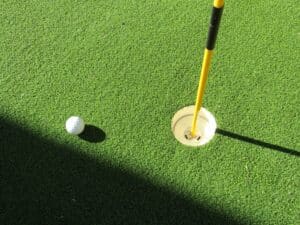
The consistency and durability of artificial grass make it ideal for sports fields and recreational areas. It provides a reliable, even surface that reduces the risk of injuries caused by uneven terrain. The all-weather usability ensures that sports and activities can continue year-round, regardless of weather conditions. Additionally, the predictable playing surface enhances athletic performance.
19. Less Attractive to Insects
Artificial turf’s composition makes it less attractive to insects compared to natural grass. This reduces the likelihood of insect-related problems and makes outdoor spaces more enjoyable. It’s particularly beneficial in areas where mosquitoes and other pests are prevalent, as it helps to reduce their breeding grounds. This feature also contributes to a cleaner and more hygienic outdoor environment.
20. Easy to Clean
Maintaining the cleanliness of artificial grass is straightforward. It can be easily cleaned with a hose, broom, or leaf blower. This ease of cleaning is particularly useful for removing debris, pet waste, or spills. The low maintenance aspect is a significant time-saver and ensures that outdoor spaces are always presentable and ready for use.
21. Quick Installation
The installation process for artificial grass is relatively quick and straightforward, especially when compared to growing a natural lawn. This quick installation means immediate transformation of outdoor spaces without the waiting period associated with seeding and growing natural grass. It’s ideal for projects with tight timelines or for those who want an instant upgrade to their landscaping.
22. No Seasonal Limitations
Artificial grass is not affected by seasonal changes, maintaining its appearance and functionality year-round. This is particularly advantageous in climates with extreme weather conditions, where natural grass might struggle to survive. The all-season usability makes it a practical choice for various applications, from residential lawns to commercial landscapes.
23. Space Efficiency
Artificial turf can be installed in areas where natural grass is difficult to grow, such as shaded, indoor, or rooftop spaces. This space efficiency expands the possibilities for landscaping and garden design. It allows for green spaces in urban environments where natural grass might not be feasible.
24. Improved Playability
The uniform surface of artificial grass improves playability for various activities. It’s particularly beneficial in sports, where a consistent playing surface can impact the game’s quality and safety. For children’s play areas, the even surface reduces the risk of falls and injuries, making it a safer option for active play.
25. Reduced Heat Island Effect
Artificial grass can help mitigate the urban heat island effect. Unlike surfaces like concrete or asphalt, it does not absorb and radiate heat to the same extent. This feature can contribute to cooler urban environments, especially in densely populated areas.
26. Non-Flammable Material
Most artificial grass products are made from materials that are resistant to fire. This non-flammable nature makes artificial turf a safer option in areas prone to wildfires or for use in fire-sensitive environments. It adds an extra layer of safety, particularly in residential settings.
27. Eco-Friendly Options Available
There are eco-friendly options available for those looking for a more sustainable choice. Many manufacturers now offer artificial grass made from recycled materials, reducing its environmental impact. These eco-friendly options are gaining popularity among environmentally conscious consumers and contribute to a more sustainable product lifecycle.
28. Customizable for Specific Uses
Artificial grass can be customized to suit specific needs and applications. Different pile heights, densities, and textures are available, making it suitable for everything from putting greens to children’s play areas. This customization allows for optimal performance and aesthetic appeal, tailored to the specific requirements of the application.
29. Reduced Soil Compaction
Unlike natural grass, artificial turf does not suffer from soil compaction. This means it maintains its cushioning properties over time, providing a more comfortable surface for walking and playing. Reduced soil compaction is particularly important in areas with heavy foot traffic, where natural grass can become hard and uncomfortable.
30. No Need for Returfing
In high-traffic areas, natural grass often requires frequent returfing to maintain its appearance and functionality. With artificial grass, this is not necessary, as it maintains its integrity despite heavy use. This benefit is especially relevant for sports fields and public spaces, where the constant upkeep of natural grass can be costly and time-consuming.
The journey through the 30 artificial grass benefits reveals a clear picture: it is more than just an alternative to natural grass; it’s a smart, sustainable choice for modern living. For homeowners and commercial property managers, the advantages are undeniable. From the significant cost savings over time and low maintenance requirements to the environmental benefits and aesthetic appeal, artificial grass meets the diverse needs of today’s residences and commercial spaces. Whether you’re looking to create a safe play area for children, a pet-friendly yard, or a lush, green commercial landscape with minimal upkeep, artificial grass offers a practical and beautiful solution.
More Resources
The Ultimate Guide to Synthetic Turf: Everything You Need to Know
